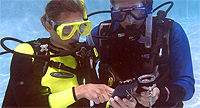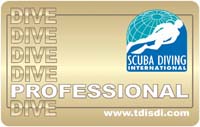Should My Name Be On This Card?
By: Sean Harrison

Every diving professional has had to make the decision “should I certify this diver?” and sometimes the answer is no. Most would work tirelessly with the customer to get them through or turn them over to another instructor that may have a different technique or fresh perspective. There are those times though when the customer just cannot meet standards or lacks the judgment needed to perform dives as safely as possible.
The other time you should ask yourself “should my name be on this card?” is when you did not teach the majority (or any) of the course that the customer is to be certified in. It is a fairly common (but not wise) practice for instructors wanting to move up the ladder to put their names on cards. Before we tackle why that is not a wise choice, let’s first look at the intention on that standard.
Agencies that require minimum certification numbers as prerequisites for higher level leadership courses generally do so in order for the instructor to gain experience. The only way for an agency to document experience is through the issuance of a certification card. If certifications are issued under an instructors name, for the sake of numbers, and that instructor had nothing or very little to do with the course, it defeats the intention of the standard; chances are good that whatever course they are aspiring to take, they will inevitably fail due to – you guessed it – lack of experience. This is the nice side of why it is a bad idea to practice boosting numbers when someone else teaches the course.

Now eventually it will come out that someone else taught the course and they will be brought in to defend their actions, but in the meantime you were just dragged through the wringer and your credibility from that point forward is shot. The simple way to resolve all this is to put the name of whoever actually teaches the course on the card. Most, if not all, agencies have the ability for two names to go on cards, that way both instructors can get credit.
Finally, from a customer relations standpoint, when a customer works with someone for an extended period of time (especially if that customer had a difficult time and the instructor helped them work through it), they want “their” instructors name on the card not, some person they bumped into once or twice while they were in the store. So next time you go to fill out a registration form, ask yourself, ”should my name be on this card?”
Stay informed, and please keep your Pro Member profile up to date. Visit https://www.tdisdi.com and log in to check it out today!

